|
Home |
Blair's Blog |
Facebook |
Youtube |
TV10 |
TV10 Archives |
Weather

| 1885 Upper Ragged Mountain Reservoir.
City tax rate jumps from 60 to 90 cents.
|
Water Supply History. Thursday October 5, 2017.

| | 1885 Pump House.
|
Local authorities are calling for voluntary water conservation since 3.5 inches rain fell back on May 5. Has the recent rainfall shortage translated to shortage of water supply? Is this another false alarm? The Rivanna water authority has a history of hysteria and hoaxes. Let's start ten years ago.
2007: Year Of The Non-Drought. Jan. 3, 2008.
For the third time since the Rivanna Water and Sewer Authority was created in 1972, Charlottesville and Albemarle enacted mandatory water restrictions in
August 2007. Just yesterday (Jan. 2, 2008) RWSA executive director since 2004 Tom Frederick downgraded the agency’s Drought Warning to a Drought Watch, clearing the way for the city and county to lift restrictions.
In 1977 the severity of the water shortage was measured in days of supply remaining. In 2002 the water shortage was measured in percent of total capacity. Because the 2007 drought was still milder, the new metric is level of reservoirs below full. But the height of the dam and area of the reservoir are never given, making it a meaningless metric. Today The Daily Progress, WCHV and WINA filled up space and air time with the meaningless measurements.

| | Questions from the Start.
|

| | 1908 Lower Ragged Mountain concrete coupled with earthen when dam integrity and bedrock were questioned. (43 Days supply combined.)
|
The numbers keep changing in order to avoid historical comparisons. In 2000 the trigger for mandatory restrictions was 60% of capacity, in 2001 65%, in 2002 70%. In Nov.-Dec. 2001, reserves fell to 68% before reservoirs filled without any rain. In 2007 the water shortage was 93% of full. In 2006 the metric was in-stream flow, removing the water supply itself as a factor in determining whether water restrictions are warranted.
On Sep. 13, 2007, Frederick held a forum at Lane Auditorium in the Albemarle County Office Building at the foot of Vinegar Hill. He kicked off the forum on how to finance the $142 million Ragged Mountain reservoir expansion by saying he wanted to focus on the future. The city and county approved the plan in 2006. Virginia Department of Environmental Quality has approved the plan. The State Water Control Board is expected to approve the plan in March (“Localities set to lift limits on water use” by Jeremy Borden, Jan. 3, 2008, The Daily Progress).

| | 2006 Water Supply Plan. Blue(I64) Yellow(Bypass) Green(29North) Red=Cancelled bypass right-of-way. Pipeline from Rivanna W(Walmart) U(University Hall) B(Birdwood)
|

| | 2012 Ragged Mountain earthen dam 2006 water plan 45-foot additional height.
|
But members of the public complained that RWSA was editing its website to keep the public uninformed, to remove historical information so that documents posted only a year previously had already been removed. The website did not contain basic information such as when the dams were built, how much water they hold, or how tall the dams are (reference for water measurements below top of dam).
Ragged Mountain’s upper reservoir was built 1885 and expanded 1908. Combined Ragged Mountain contains 460 million gallons when full, or 43 days of supply at average daily demand of 10.6 million gallons per day.
Sugar Hollow was built 1924 and holds 360 million gallons or 33 days. A pipeline connects Sugar Hollow to Ragged Mountain. When expanded, a pipeline would bring water from South Rivanna to Ragged Mountain. Water from Sugar Hollow would return normal flow to the Moorman’s river.
The South Rivanna reservoir began operation in 1966, and now contains 750 million gallons or 70 days of water, a third less than 1966 because of sedimentation.

|
|
Director Tom Frederick Sep. 13, 2007 meets growing opposition.
|

| | 1924 Sugar Hollow with pipeline to Ragged. (33 Days supply.)
|
When reservoirs are full, we have 146 days or 20 weeks of supply at normal demand. In 2007 supply fell to 135 days (93%). Until a member of the public demanded this information on Sep. 13, no one was able to quantify the non-severity of the current “drought.”
The city of Charlottesville acquired land for South Rivanna in 1962. The reservoir flooded Hydraulic Mills, the commercial center of the African American community of Union Ridge dating to the early 1800s. John Perry built the mill 1818 which supplied much of the lumber used to build the University of Virginia.
The mill complex included “a grist and merchant mill, a miller’s house, a cooper’s house, a storehouse, a blacksmith’s shop, a country store, and, briefly, a silkworm industry.” Hydraulic Mills became the head of navigation for bateaux commerce on the Rivanna until an 1870 flood “ended river navigation in Albemarle County forever.” (“The Life & Legacy of Hugh Carr: River View Farm” brochure at Ivy Creek Natural Area. Ivy Creek Foundation )
|
South Fork History
1962 South Fork Rivanna Reservoir land purchased and still owned by the City.
1966 SFRR filled and water production begins in August.
1968 First Albemarle zoning allows high density development.
1969 Four fish kills at night possibly due to low oxygen. Hurricane Camille in August.
1970 SFRR closed for two weeks after fish kill attributed to Endrin discharge at Crown Orchards.
1972 Fish kill at Lickinghole Creek attributed to ammonia spill at Morton Frozen Foods. RWSA formed. Clean Water Act. Hurricane Agnes in June.
1973 RWSA forms advisory committee on reservoir pollution.
1974 City asks county to downzone near SFRR. UVa says SFRR is "sick."
1975 EPA says accelerated pollution is occurring.
1976 Albemarle begins downzoning. Nature Conservancy, City, County, and Virginia Commission on Outdoor Recreation purchase 80 acres as Ivy Creek Natural Area.
1977 Clean Water Act tightens restriction of discharge of toxins.Worst drought on record. First mandatory water conservation for 35 days.
1979 Watershed Manager official created. Hurricane David in September.
1980 Downzoning appealed to Virginia Supreme Court, Albemarle prevails.
1981 81.5 acres added to Ivy Creek Natural Area.
1983 Land purchased for possible future Buck Mountain Creek Reservoir.
1988 Hydro power plant installed. Virginia bans phosphates in detergents.
1995/ Major flooding in region.
1996 Sugar Hollow Reservoir placed on dam failure alert after heavy rains. Blizzard of '96 in January, Hurricane Fran September.
2002 Second mandatory water restrictions begin August 23.
|

| | 1966 South Rivanna the day after Hurricane Isabel Sep. 19, 2003. (70 Days supply.) The 2006 water plan features a pipeline from Rivanna to Ragged. Sugar Hollow pipeline to be decommissioned.
|
Following the drought of 1977, RWSA acquired 1,300 acres in 1983 near Free Union for Buck Mountain Creek reservoir on a tributary of South Rivanna. But the dam was never built because the endangered James River Spiny Mussel was found. RWSA never returned the land to its owners. In Feb. 2004, RWSA chairman Mike Gaffney said at a City Council meeting that the reservoir might not be built for a hundred years, but the agency is keeping the land as an “insurance policy” against future water demands.
In late 2006, the agency unveiled a plan to use Buck Mountain land in the mitigation plan to replace inundated wetlands and to quadruple the size of the Ragged Mountain reservoir from 460 million gallons to 1,590 million gallons. The pool elevation would be 45 feet higher than today and extend under Interstate 64. Because of the small drainage basin, a pipeline from South Rivanna will fill the mega Ragged Mountain reservoir.
In 2007 RWSA floated the idea to abandon the South Rivanna and allow the reservoir to completely siltate rather than dredge. Today Rivanna holds about half the water supply. When Ragged Mountain is expanded, Rivanna will hold a quarter of the supply and shrinking over time due to siltation.

| | 1983 Buck Mountain land seized but reservoir never built for 1977 record drought 35 days mandatory water conservation. 2004 RWSA is keeping land as "insurance policy."
|
The expanded Ragged Mountain will flood hiking trails surrounding the existing lakes. Councilor Kevin Lynch and others have asked that this “park land” be replaced with park land elsewhere. But RWSA explained the trails will be relocated to higher ground and expanded, and the financing of that relocation is a point of discussion.
Director Frederick said the trails are on reservoir land acquired in the 1880s for the purpose of future expansion. In December Mayor David Brown made the same argument, explaining we must sometimes invest in the future as past generations have done.
2011 Turning Point For 2006 Plan When Opposition Arises.
Despite the rare consensus and almost unanimous support to centralize the water supply back to the first reservoir, opposition from the City began to arise and would become bitter and personal. "If you disagree, you're dumber than a 4th grader" became the low-point in the logic.
The opposition could be seen Sep. 13, 2007 when City residents wanted to shift costs to the County and to future users. The audience at old Lane High wanted to know why documents and resources were disappearing from the agency's website. When a few metrics were pried out of staff, Blair's Blog was able to compute the 2007 drought at 93% capacity. Just 5 years earlier the drought trigger was 70%.
The public may have been angry that Rivanna floated a trial ballon that the South Rivanna reservoir would be abandoned, allowed to siltate, and water siphoned off to the new mega Ragged Mountain. Finally, after multiple submitting proposals to dredge across several years, which were ignored, the professionals gave up. Then Rivanna issued a Request For Proposals and nobody responded. Of course Rivanna had no idea why no one would be interested in dredging.
Perhaps there was frustration left over from the 2006 attempt to ouster Virginia climatologist Patrick Michaels. City Councilor Kevin Lynch and Blogger Waldo Jaquith led a McCarthy-style crusade to fire Michaels for not being alarmist. Michaels agreed on every other point of global warming. A year later Michaels resigned anyway.
City Council approved the current water plan June 2006 and again June 2008. Yet the opposition grew as former city councilors claimed they had been duped. The climax was 2011 when City Council threatened to take over the Rivanna agency.
Let's Re-Start the Timeline at 2001.
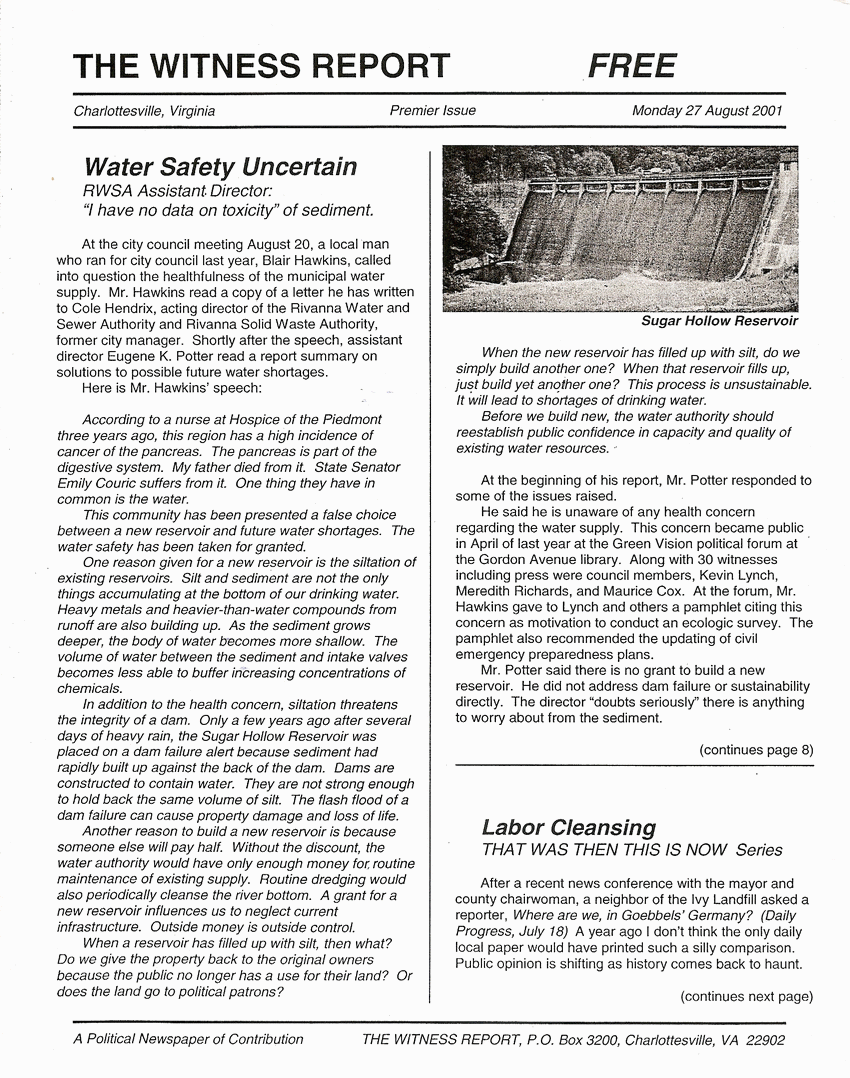
|
|
Blair Hawkins' Aug. 20, 2001 Speech on Dredging.
|
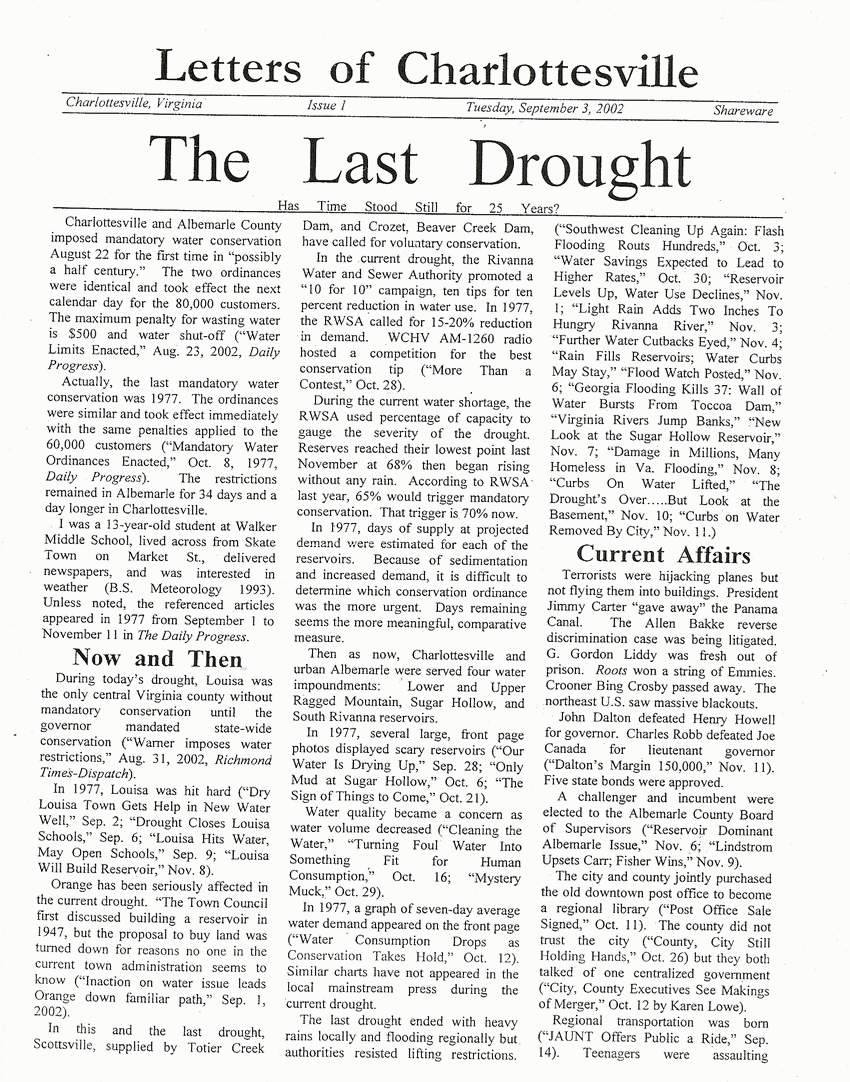
|
|
All About 1977 Lost Drought. How front page didn't know after several years of false alarms. Sep. 3, 2002.
|
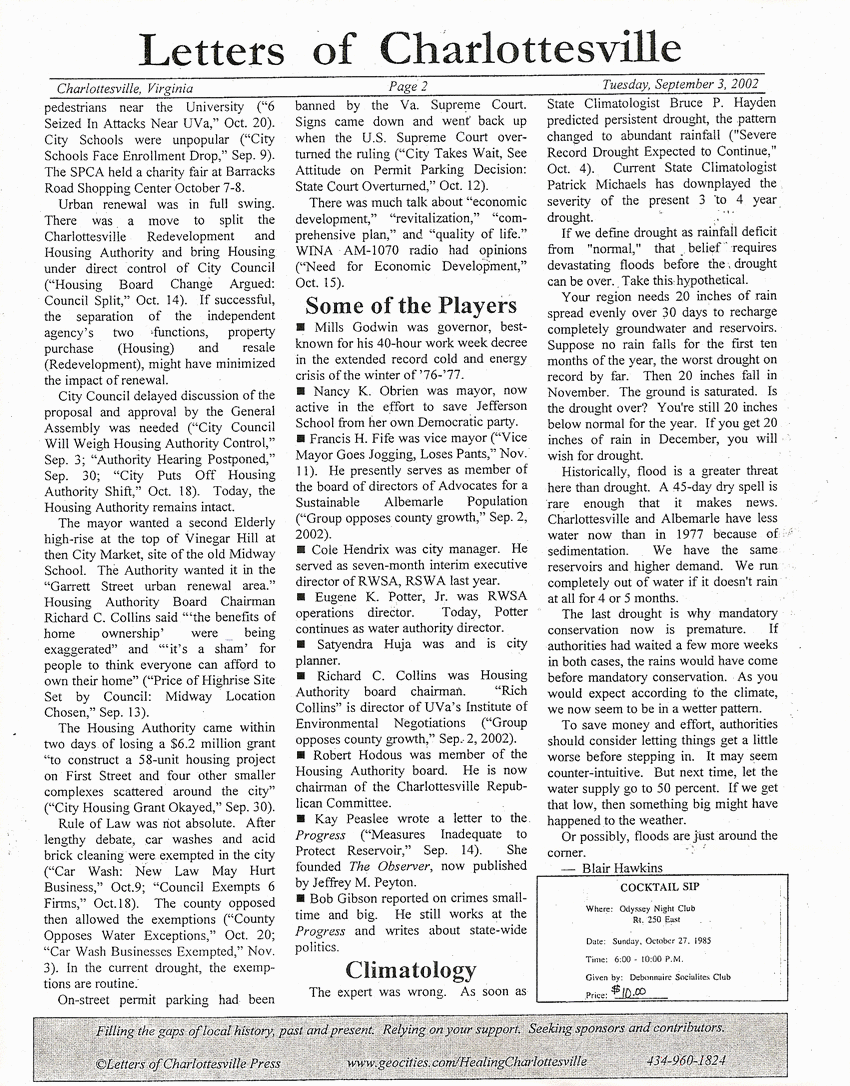
|
|
In 2002 drought, high-profile leaders in 1977 don't tell the media about 1977 record drought.
|
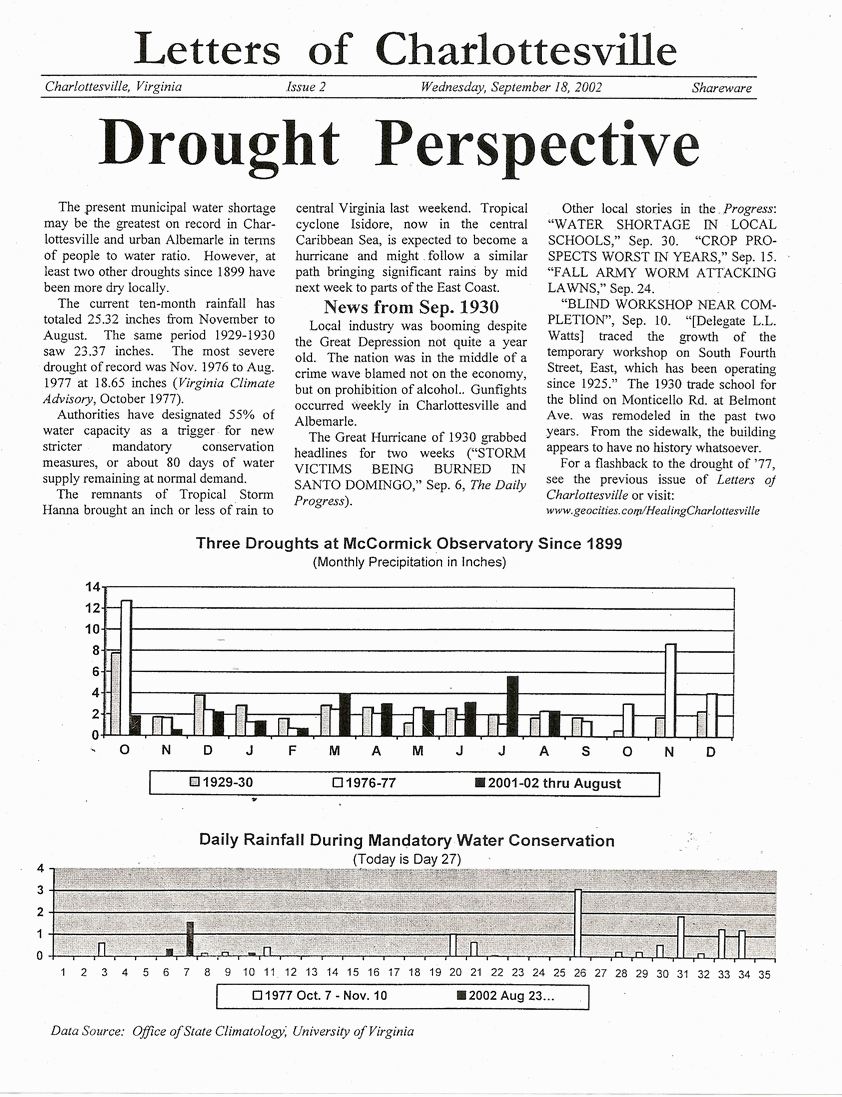
|
|
Analysis confirms 2002 drought is mild, 1930 drier, 1977 the driest on record. Sep. 18, 2002.
|
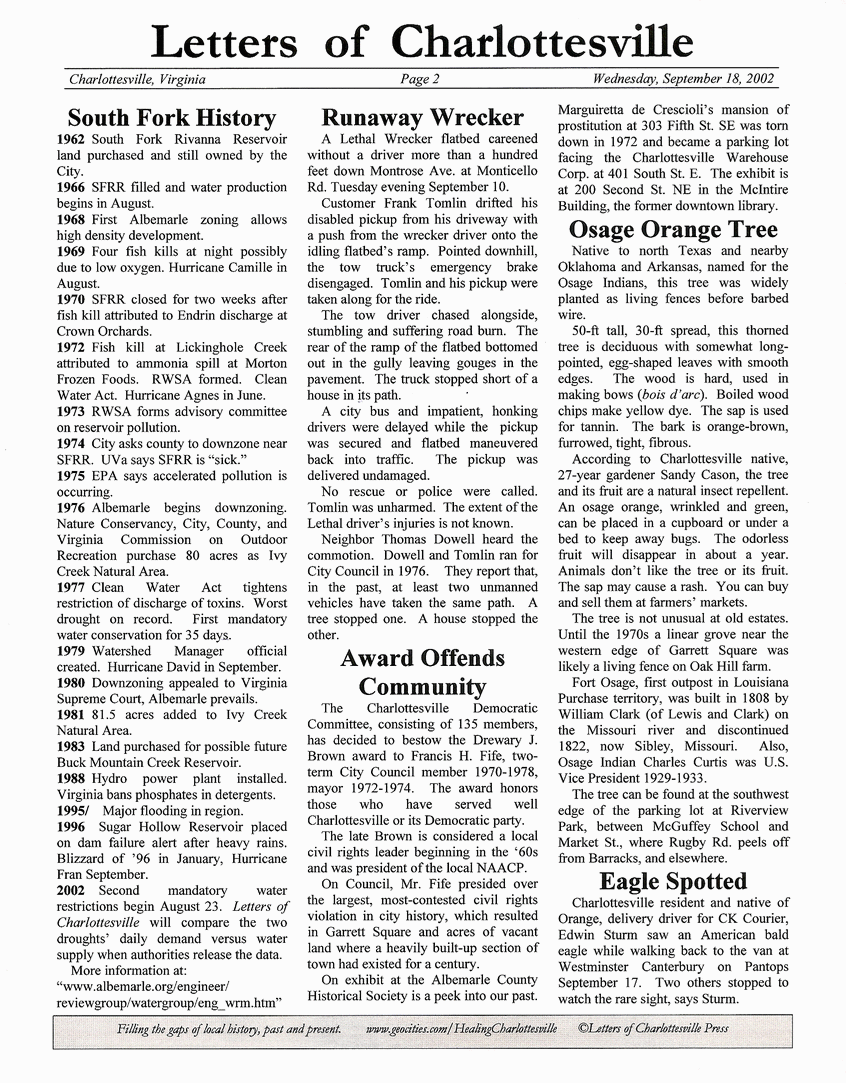
|
|
Timeline South Rivanna.
|



Home | Charlottesville, Virginia | blair@blairhawkins.net | Résumé | Top
|


